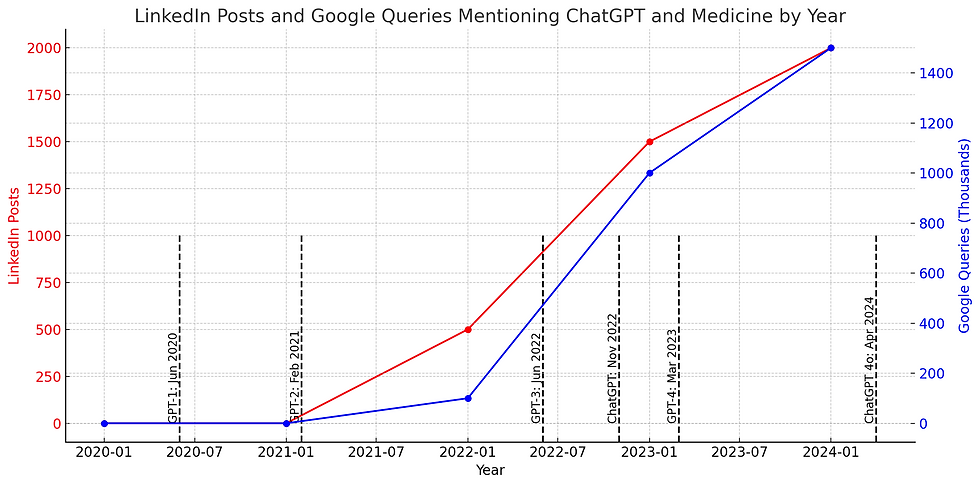ChatGPT: Healthcare’s disruptive monkey wrench
- Ozzie Paez

- Jul 8, 2024
- 2 min read
ChatGPT 4 threw a significant monkey wrench into American #healthcare. It quickly overcame the industry’s formidable barriers to entry, sidestepped regulatory constraints, and attracted millions of user-patients. A key reason for its success is that #GPT, the Large Language Model (LLM) behind #ChatGPT, was engineered and promoted as the first general artificial intelligence (#AI) tool designed for everyone, something many leading thinkers, including Sam Altman, #OpenAI’s founder, believed was necessary to propel AI to the next level. As a result, most #LLMs, including ChatGPT 4, operate in the same space as the Internet and outside the regulatory scope of industry-specific agencies like the FDA.
ChatGPT demonstrated staggering growth in building a user base of approximately 180 million active accounts in about five years (Figures 1 & 2). ChatGPT 4 is notable because it was the first broadly available LLM with the sophistication, training, and analytical capabilities to evaluate complex patient symptoms, diagnose causes, identify treatment options, and offer second opinions. User-patients give the platform high marks for its low costs, accessibility, and convenience. They also value having as much time as they need to 'consult' on health issues, treatment strategies, and health support options that meet their needs, preferences, lifestyles, jobs, etc.
Figure 1
Figure 2
Figure 3
ChatGPT 4’s intrusions into traditional #clinical care and #doctor-patient relationships triggered mixed reactions from researchers, clinicians, and leading executives. Many doctors and #nurses raised concerns about potential interference with #patient relationships, which they consider indispensable to quality care. Doctors and researchers have highlighted the technology's limitations and risks to untrained patients who may uncritically accept advice without consulting their doctors. I shared the results of our tests and investigations, which supported these concerns. The controversy continues but has not deterred millions of user-patients who view the platform as a valuable, trusted, affordable, and accessible healthcare tool and option.
The accompanying plots illuminate ChatGPT 4’s growth since its release in March 2023. No technology in modern times has rattled the healthcare industry more deeply and built a larger patient base than ChatGPT 4/4o. It’s even more impressive that it happened in less than eighteen months. These trends should concern healthcare leaders because they parallel others from previously disrupted businesses, markets, and industries. Customers (patients) are key because their response to the alternative compelling value propositions offered by LLMs like ChatGPT will determine if these remarkable technologies prove disruptive to legacy healthcare or fizzle with a whimper.
My next posts will explore the factors driving patients’ acceptance of ChatGPT 4/4o and their broader implications for the business and practice of #medicine. I will also share potential solutions based on our use, tests, and investigations of complementary technologies, including physiological sensors, wearable monitors, and remote patient monitoring systems. Please reach out with questions and feedback. Solutions for vexing problems often begin with a conversation.








Commentaires